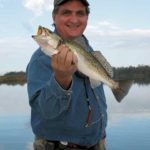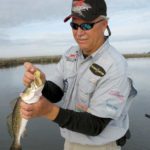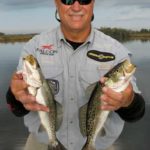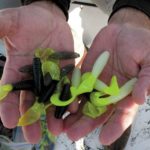
Both your gas tank and your ice chest will be full after a short trip this month to Lafitte’s resurgent Texaco Canals.
It seemed strange to motor past the area where all the other boats were turning in, but that’s exactly what we did.
All the news out of Lafitte for the past week was that the Pen was on fire. Speckled trout action was red hot, and anglers were coming from all over to make the short hop from the marinas to the perennial hotspot.
The neat thing about the Pen is that you almost can’t go wrong. It’s located a stone’s throw from any of Lafitte’s marinas, so you don’t need complex directions or a big boat or a tank of gas to get there.
Like most areas, the Pen can run hot or cold, but when it’s hot, the fish will hit almost anything you toss, and every angler, be they amateur or pro, can catch his share. And there are no secrets here — no secret spots or secret baits or secret techniques. Just line up where you see all the other boats (be courteous, of course), and start casting. The area is big enough to host an armada of boats, and when the fish are in there, there will be an armada pursuing them.
The armada was out in full force on this recent, cold winter morning, and every boat we saw either made the turn into the Pen from the Barataria Waterway, or they were already in there.
But we didn’t turn. We motored right past the cut and headed farther south toward the Texaco Canal system, where we figured not only would there be fish, but we’d have them virtually to ourselves.
Capt. Mike Daigle called just a night or so before, and told me of an exploratory trip he’d just made into the Texaco Canals.
“Twenty-five casts, and twenty-five trout,” he said.
He didn’t have to say anything else.
“When are we going?” I asked.
So, here we were, headed south into that confusing hodge-podge of cuts, canals and dead-ends collectively known as “The Texaco Canals.”
If you look at the area on a chart, it looks exactly like what my grandmother used to call “chicken scratch.” It’s a bunch of lines on a map running in all directions without apparent rhyme or reason. Of course, when the oil companies dug all those canals, they had a reason — oil! Black gold and natural gas, resources Louisiana held in abundance and the whole country clamored for. The canals were a hubbub of oilfield activity for decades back when it was profitable to work them rather than import everything.
But when they became unprofitable, the oil companies capped them up and abandoned them faster then rats desert a sinking ship. Unfortunately, they didn’t bother too much with cleaning up their mess. Almost everywhere you look in Lafitte’s waters, you see oilfield debris. This is not the debris of Katrina’s aftermath, but a shameful testimony of how roughshod the oil companies formerly ran over Louisiana’s fragile marshes.
Not only is the debris unsightly, it poses serious navigation hazards. I couldn’t help thinking that no state in the Union would have allowed this kind of pillage.
But now, with the recent surge in oil and gas prices, it’s become profitable once again to work the old wells and even drill some new ones, so tugs, barges and workboats are back, ferrying workers, checking gauges and pumping oil and gas from deep underground.
For anglers, the canals are always a winter draw, where structure and deeper water combine to provide forage and habitat for fish seeking a place to ride out the coldest months of the year.
Our plan was to work back toward the area known as the Clearwater Canals because its one of Daigle’s favorite winter haunts. But since virtually all the boats were snuggling together in the Pen like a football team in a huddle, we had the whole Texaco system almost to ourselves. Daigle decided to kill the outboard and test the waters in one of the main canals.
“We don’t usually fish this canal too often because of the boat traffic running through it,” he said. “There are fish in here, but just about every time you get them started, a boat will pass by and shut everything down for 15 minutes or so. And just when it starts up again, here comes another boat. So, as a result, we just don’t fish here because it’s too frustrating.”
We had invited Capt. Papa Joe Bush to fish along with us, and looked forward to his company, but he said he had come down with the flu or something and couldn’t make it. I suspected he went duck hunting instead, but I refrained from mentioning my suspicions.
So with just Daigle and me aboard, we had the whole boat to ourselves, and the whole Texaco System to ourselves. And with my very first cast, I had a good thump on the business end of my line. But I was unprepared for such immediate action, and my reflexes seemed to respond in slow motion. Daigle got thumped twice before he reeled in an empty hook as well.
“One of the most important things about winter fishing is having a sensitive rod,” Daigle said. “I prefer to use a 7-foot medium- or medium/light-action Falcon for fishing these canals because the rod is so sensitive.
“When I fish with more people in the boat, I use a 6-foot, 6-inch medium-action rod, which, in my estimation, is the best overall multipurpose rod for speckled trout and marsh reds.
“I prefer a baitcasting reel for tightline fishing, but a spinning reel is a fine tool also. And though some folks prefer braided line for winter fishing because of the added sensitivity and its lack of stretch, I just don’t like fishing with braid. I find that when you fish often, braid tends to tear up your tackle. I spool up with 12- to 15-pound-test Stren or Berkley mono, and I rarely ever lose a fish due to breakage.”
I understood completely where Daigle was coming from. I carry on a love-hate relationship with braids. Last year, I restrung most of my reels with braid and I loved it — for awhile. But backlashes and difficulty tying knots and similar aggravations made me switch back to monofilament. This year I have all but one reel spooled with 12-pound mono, and I much prefer it for simple, overall ease of use. But who knows what next year will bring?
I was better prepared on my next cast, and when my bait got thumped, I set the hook. I landed a 14-inch trout — not bad for winter fishing — and tossed my bait right back to the same spot.
Daigle and I both started getting bumped on every cast, but the persnickety fish weren’t always taking the hook.
“Usually by this time of year, the fish are somewhat smaller in size, and they can be a lot more finicky,” Daigle said. “I like to use a curl-tail bait in the winter, but not a real big bait. Generally, smaller baits and lighter jigs will produce more fish in winter than the heavier, larger baits.”
Daigle was fishing with a High Tide curl-tail in the smoke/chartreuse color on a 3/16-ounce jig. I was tossing a Hybrid in the key lime color on a ¼-ounce jig, and over the course of the morning, we both got plenty of attention from the fish.
Daigle let the boat drift down the center of the main canal, and we tossed our baits toward the shore and then worked down the ledges. Sometimes the fish seemed to be right on the drop-offs, while at other times the action moved to the middle of the canal in the deepest water.
But at no time did the fish stop biting. When the action slowed to a trickle, we motored back to our original starting point and re-drifted the area again — with the same results. We either caught a fish or had good thumps on almost every cast. Several of the fish we caught were undersized, and we also tossed back all the 12-inch fish, keeping only those 13 inches or better.
We had drifted out of our main strike zone once again and were getting close to our limits when a small flatboat with a lone angler motored up to our original starting point and tossed anchor. We had moved off the spot, so he wasn’t infringing on us, and we watched as he caught fish on his first cast and on almost every cast thereafter.
We were only 11 fish shy of our two-man limit, and I suggested we catch one more and call it an early morning. We could be back at the dock with 40 nice trout by 9:30 a.m. But we doubled up, and each caught a nice fish, making for 41 in the box.
“You know that means we have to stay and catch our limit, don’t you?” Daigle said.
“You’re right,” I replied. “The day is young, the sky is clear, the fish are biting. What’s the hurry to leave?”
We also managed to put a few reds in the boat, but kept only one for the grill.
Daigle says all of the canals throughout the Texaco system will hold fish this month and next.
“And when its real cold, you don’t have to be out here at the crack of dawn,” he said. “You can wait a while and let the sun come out and warm things up a bit. Fish the deeper waters in the canals, along the ledges and flat on the bottom in the middle.
“If we get a warm spell, you’ll even be able to fish under a popping cork.
“Redfish will hang in most of the same areas, and you’re likely to put several of them in the box along with the trout.
“If you want to specifically target reds, you can work the drains from the ponds along Bayou Labit, Bayou Dupont and all the canals here in the Texaco system. If the conditions are really tough, sweeten your bait with a piece of dead shrimp, and park it on the bottom. You’ll catch reds, drum and occasional sheepshead and flounder.”
The action was slowing as we struggled to catch the few more we needed to limit, but the fish we were catching were also slightly larger. We needed two more fish when the lone angler in the flatboat picked up his anchor and headed toward us. When he got within shouting distance, he told us he had his 25-fish limit and suggested we move over to his spot because he picked up and left them biting. It was a nice gesture, and I like it when anglers are willing to share their spots. We thanked him and went back to our original spot and quickly topped off our limit.
We didn’t make it back to the dock by 9:30, but we were back by 10:30 with our two-man limit of very nice Lafitte trout.
“Overall, it’s been a great year for speckled trout here in Lafitte,” Daigle said. “There’s plenty of fish, and they’re good sizes, too. This action will last all winter, and then I expect a really great spring run.”
I’m inclined to agree.
I only hope Papa Joe had a good day in the duck blind, because he sure missed a good trip on the water.
Capt. Mike Daigle can be reached at (504) 915-9480.








